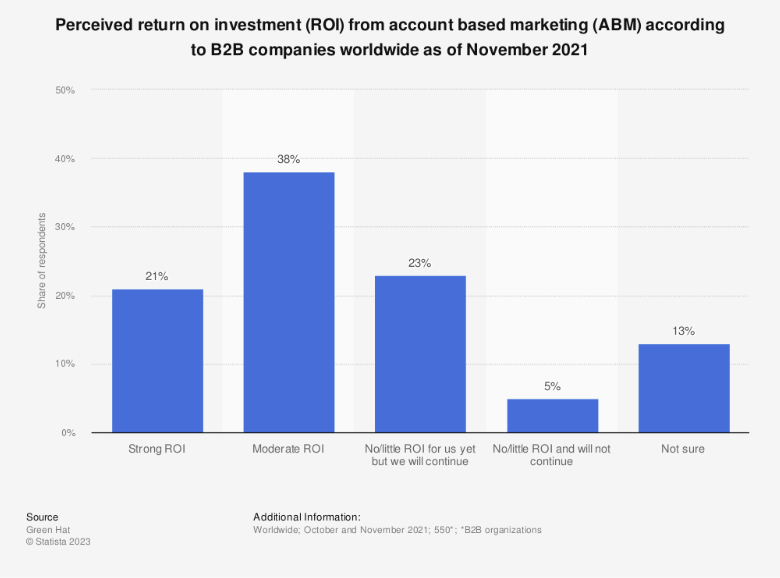Account based marketing (ABM) has become one of the hottest new trends in marketing. It produces impressive results, making it a firm favorite strategy among leading companies, business startups and marketers.
You may be wondering, beyond just being an in-vogue strategy for creating awareness and driving sales, what makes account based marketing so effective?
At a high level, here’s the scoop: With ABM, customers are treated like individual accounts even when they’re grouped as leads within the same company or vertical. Each ABM campaign requires careful planning and an intimate understanding of what will resonate with each customer segment. It relies on tailored experiences to win a customer. While this strategic approach may require additional investment, the potential rewards outweighs the risk.
If you’re looking to get started with ABM—or need some fresh ideas for your existing program, we’ve got you. We’ve put together some of the best ABM examples that drove incredible results.
First, let’s dive into what account based marketing is.
What is account based marketing?
Account based marketing is a strategic approach to marketing that focuses on creating tailored campaigns for individual target accounts. It emphasizes the coordination between marketing and sales teams to reach the right prospects with personalized content.
ABM strategies are anchored on increasing engagement with key accounts to drive better results, such as higher quality engagements, more customer conversions and bigger deals.
For example, if a company wants to target high-end accounts, it can create campaigns with special offers and incentives designed specifically for those accounts. With ABM, companies can target the right accounts and create content that resonates with those accounts’ specific needs and interests.
You can think of ABM as “one-to-one marketing,” where you tailor your messaging to each account instead of casting a wide net.
What are the benefits of account based marketing?
We’ve lightly touched on the benefits of ABM already, so let’s go deeper. They include the following.
#1. Targeted approach
Account based marketing allows you to direct your efforts (and resources) more precisely. By having an accurate view and intimate understanding of the customers you’re trying to reach, you can create content and campaigns tailored specifically to them.
#2. Increased ROI
ABM strategies increase ROI because you’re focusing on accounts with the most potential. The tailored campaigns you build for your target accounts optimizes your spend, helping you avoid spending time and money on broad campaigns on a wide array of potential accounts that may or may not be receptive to the message.
In 2021, a global survey of B2B companies revealed that most had seen moderate success from their account based marketing (ABM) strategies. More than 1 in 5 even reported strong returns. Though nearly 30% saw little to no ROI, the vast majority were still moving forward with the strategy and working toward finding the right approach.

#3. Improved customer relationship
ABM allows you and your company to create a deeper connection with prospective and existing customers. As they begin to feel more valued and appreciated, their loyalty and engagement increases.
#4. Better insight
Through ABM, you can also come to better understand your customers’ needs and wants. As you dive into segmenting your targets, you’ll begin to develop more accurate customer profiles that can guide you in building meaningful campaigns that speaks to the challenges and opportunities they have.
#5. Increased reach
Account based marketing gives you the opportunity to reach more customers. Now, I kow that sounds counterintuitive because we just said that ABM helps you target a specific set of accounts. But here’s the truth behind it all. By understanding the needs and wants of your target audience, you can create campaigns that more people will see. You’ll no longer be throwing spaghetti at a wall.
#6. Manageable costs
ABM also allows you to be very precise about how you allocate your budget. You’ll know if anything you spend is moving the needle at the account level and you’ll know where to invest more.
Examples of great ABM campaigns
The moment you’ve been waiting for: examples of strong ABM campaigns. Here are a few ABM campaigns to inspire your next one.
GumGum personalized storytelling
GumGum, an AI contextual intelligence company, leverages ABM for its “personalized storytelling ” approach. Specifically, they used this approach to close a big deal with T-Mobile.
GumGum was able to gain insight into the preferences of its target client through research. They discovered that T-Mobile’s CEO was a huge Batman fan and used this information to their advantage.
Knowing this, they printed out personalized comic books called “T-man and Gums,” featuring the CEO as the main character. It generated a lot of buzz and excitement among T-Mobile’s agencies, which helped GumGum secure the deal.
As a result of using an ABM strategy, they witnessed great success in their campaign and gained traction among their target accounts. Their sales pipeline rose by more than 10x.
LiveRamp’s hyper-targeted approach
LiveRamp, a data onboarding company, also experienced success with its ABM strategy.
They made a 33% conversion rate in 4 weeks after creating a comprehensive list of their 15 highest-value clients and targeting them with multi-channel campaigns. The list included the clients’ names, contact information and preferences. Their campaigns included emails, snail mail, webinars, and personalized content tailored to these accounts’ specific needs and wants.
Then, they tracked the responses for each channel and analyzed which was the most effective. While the campaigns were targeted, they also included a “bait” element that encouraged their clients to engage with them in the future. It showed that LiveRamp was actively interested in feedback and understanding the needs of its customers.
The main takeaway from LiveRamp’s ABM strategy was identifying the most valuable accounts and assuring them of a personalized experience tailored to their needs. It helped them increase conversions and create long-term, lasting relationships with clients.
Salsify’s multi-channel account based marketing
Salsify is a product experience platform provider that helps companies to create and manage digital content for their products. To increase the visibility of their products to their target accounts, Salsify implemented an account based marketing strategy.
They planned a roadshow in New York with large companies such as Johnson & Johnson and Google to speak on their behalf. At the same time, they took to social media to find and connect with their targets.
In addition, Salsify followed up with targeted ads and emails to close dozens of accounts in 2 hours, exceeding their target conversion by 22%. With the help of their marketing and sales departments, the multi-channel account based marketing strategy created a massive success for Salsify.
The strategy increased brand awareness and made it easier to launch their product into the market. It also created a more personal experience for their clients, allowing them to tailor their message to their accounts’ individual needs and wants.
The success of Salsify’s ABM strategy demonstrated the power of multi-channel account based marketing. It showed that companies could exceed their conversion expectations by taking a more personal approach to their campaigns.
DocuSign’s segmented approach
DocuSign is a digital transaction management platform that provides businesses with an easier way to manage their contracts and documents online. Along with the challenge of having to target six different industries, they needed to find a way to connect with their customers effectively.
With the challenges in mind, DocuSign decided to create a segmented approach on its website. By asking users simple questions about their industry, they could determine which content was most relevant for each individual.
This allowed them to direct marketing efforts with industry-specific campaigns, such as webinars and whitepapers. It also helped them better understand their customers’ needs, making it easier to create more customized content that resonated with their audiences.
The result of this approach was a 22% boost in their sales pipeline, proving that segmentation can be a powerful tool in ABM. They also increased their engagement rate by over 59% as users felt more connected with the company. Also, they boosted the number of views on their page to more than 30%
By segmenting their approach, DocuSign was able to drive more traffic, increase click-through rates and boost conversation percentage from high-value accounts.
The bottom line
ABM can fuel tremendous growth results. To see that lift, you have to make sure you’re targeting the right accounts from the beginning. The superficial markers you may have once relied on—things like industry, company size, geography—are not enough.
You need to target accounts based on deeper signals, exegraphics. Exegraphics data tell you how companies operate, so you can not only target the accounts that have the characteristics you care about, but so you can also create campaigns that align with their core needs.
Curious to learn how to bring exegraphics into your ABM strategy? Contact us and we’ll show you the exegraphics behind your best customers—and even show you the accounts you’re missing from your ABM list.

